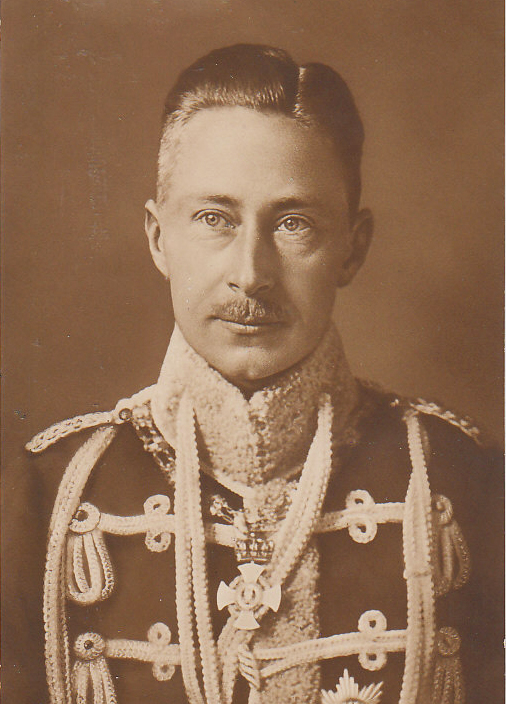by Scott Mehl © Unofficial Royalty 2019

Cecilie of Mecklenburg-Schwerin, German Crown Princess; Credit – Wikipedia
Cecilie of Mecklenburg-Schwerin was the wife of Wilhelm, German Crown Prince. She was born in Schwerin, Grand Duchy of Mecklenburg-Schwerin, now in the German state of Mecklenburg-Vorpommern, on September 20, 1886, to Friedrich Franz III, Grand Duke of Mecklenburg-Schwerin and Grand Duchess Anastasia Mikhailovna of Russia.
Cecilie had two older siblings:
- Alexandrine (1879-1952) – married King Christian X of Denmark, had issue
- Grand Duke Friedrich Franz IV of Mecklenburg-Schwerin (1882-1945) – married Princess Alexandra of Hanover and Cumberland, had issue

Crown Prince Wilhelm. source: Wikipedia
During the wedding celebrations of her brother Friedrich Franz in June 1904, Cecilie got to know Crown Prince Wilhelm who was representing his father Wilhelm II, German Emperor and King of Prussia. On September 4, 1904, Cecilie and Wilhelm celebrated their engagement at the Mecklenburg-Schwerin hunting lodge. Cecilie married Crown Prince Wilhelm in ceremonies held on June 6, 1905, in the Royal Chapel of the Berlin Palace and the Berlin Cathedral in Berlin, Kingdom of Prussia, now in Brandenburg, Germany.
They had six children:
- Prince Wilhelm (1906-1940) – married Dorothea von Salviati, had issue
- Prince Ludwig Ferdinand (1907-1994) – married Grand Duchess Kira Kirillovna of Russia, had issue
- Prince Hubertus (1909-1950) – married (1) Baroness Maria von Humboldt-Dachroeden, no issue; (2) Princess Magdalena Reuss of Köstritz, had issue
- Prince Friedrich Georg (1911-1966) – married Lady Brigid Guinness, had issue
- Princess Alexandrine (1915-1980) – unmarried
- Princess Cecilie (1917-1975) – married Clyde Kenneth Harris, had issue

Cecilienthof – court of honor. photo: By Gryffindor, panorama made by Digon – Own work, Public Domain, https://commons.wikimedia.org/w/index.php?curid=2180563
Following their marriage, the couple made their home at the Marble Palace in Potsdam, Kingdom of Prussia, now in Brandenburg, Germany, for the summers, and the Crown Prince’s Palace in Berlin for the winters and court season. Years later they had Cecilienhof built in the New Garden in Potsdam, near the Marble Palace. Construction was completed in 1917 and the family moved in right away. Although seemingly happy at first, the couple soon began to have difficulties. Wilhelm was a perpetual womanizer and made little attempt to keep any of his affairs quiet. He would often boast to Cecilie of his escapades, once even bringing her to the point of considering suicide. Despite this, their family continued to grow with the birth of their six children.
As Crown Princess, Cecilie was immensely popular and took on charity work. She particularly enjoyed working with organizations that promoted and provided education for women. She traveled extensively, including a visit to the United Kingdom in 1911 to attend the coronation of King George V of the United Kingdom. A friendship developed between Cecilie and King George V’s wife Queen Mary, and the two maintained a correspondence until Mary died in 1953. When the German Empire fell in 1918, Cecilie’s husband and father-in-law went into exile in the Netherlands. Cecilie first left Cecilienhof for the safety of the Neues Palais with her mother-in-law but was soon given permission to return to her home, and ensured of her safety. However, her husband was not permitted into the country at that time.

Oels Castle in Silesia. photo: By Agnieszka Kwiecień, Nova – Praca własna, CC BY-SA 3.0, https://commons.wikimedia.org/w/index.php?curid=27187345
The family managed to retain numerous personal properties, including Oels Castle in Silesia, where she met her husband in November 1923 after five years of separation. By then, it was a marriage “in name only”. In 1926, a settlement was reached between the German State and the former royal family. Cecilienhof became the property of the state but Cecilie and Wilhelm were given the right of residence for three generations. Cecilie based herself at Cecilienhof and stayed active in charitable organizations such as the Queen Luise Fund, the Fatherland’s Women Union, and the Ladies of the Order of St. John. All of these were later abolished in 1933 by Adolf Hitler.
Cecilie continued to live a private life at Cecilienhof in the years leading up to World War II. In May 1938, her son Ludwig Ferdinand married Grand Duchess Kira, the daughter of the pretender to the Russian throne, at Cecilienhof. This would be the last big family occasion before the war. In the midst of the war, her father-in-law died in 1941 and her husband became head of the House of Hohenzollern. The family spent most of their time at Oels Castle but returned to Potsdam in 1944 to celebrate Christmas. In February 1945, they left Cecilienhof for the last time, fleeing the Red Army. Their beloved home Cecilehof was seized by the Soviets. It would later be the site of the Potsdam Conference in the summer of 1945, hosting British Prime Minister Winston Churchill, US President Harry Truman, and Soviet leader Josef Stalin.

Churchill, Truman, and Stalin at Cecilienhof for the Potsdam Conference, July 25, 1945. source: Wikipedia
Cecilie settled in Bad Kissingen, Germany for the next several years, while her husband lived in Hechingen until his death in July 1951. The following year, Cecilie moved to an apartment in the Frauenkopf district in Stuttgart. That same year, her memoirs were published and she made another visit to England where she attended the christening of her granddaughter and enjoyed a final visit with Queen Mary. Later that year, her sister, Queen Alexandrine of Denmark, died and Cecilie never fully recovered from the loss.
Cecilie, German Crown Princess and Crown Princess of Prussia, died on May 6, 1954, her late husband’s birthday, while visiting Bad Kissingen. She was buried six days later beside her husband at Hohenzollern Castle in Baden-Wurttemberg, Germany.
This article is the intellectual property of Unofficial Royalty and is NOT TO BE COPIED, EDITED, OR POSTED IN ANY FORM ON ANOTHER WEBSITE under any circumstances. It is permissible to use a link that directs to Unofficial Royalty.
